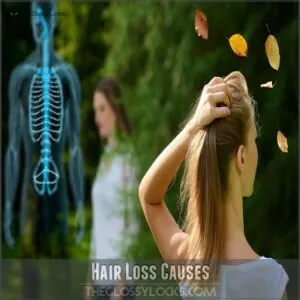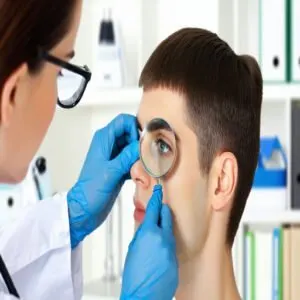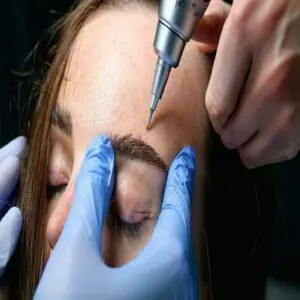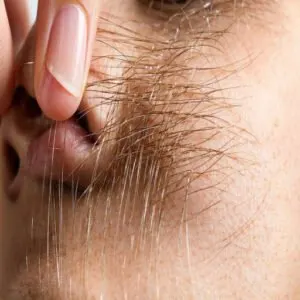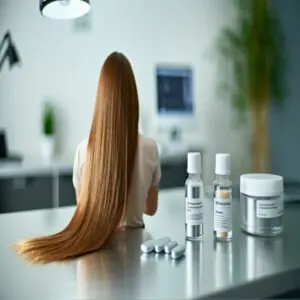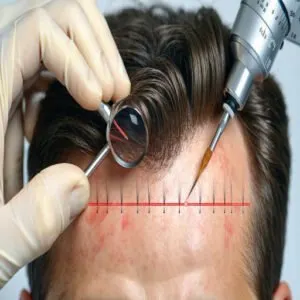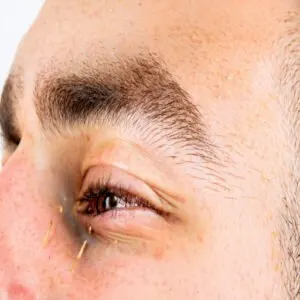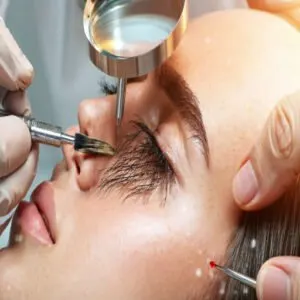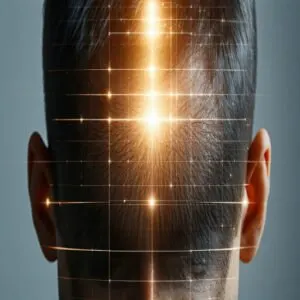This site is supported by our readers. We may earn a commission, at no cost to you, if you purchase through links.
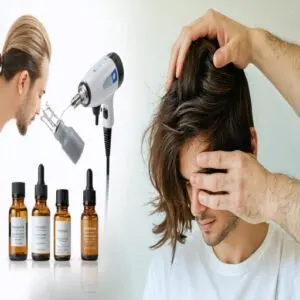
From FDA-approved medications like minoxidil and finasteride to cutting-edge solutions like low-level laser therapy and PRP treatments, science has your back.
If you’re looking for permanent results, hair transplant surgery offers lasting solutions through techniques like FUE and follicular unit transplantation.
Don’t overlook the power of lifestyle changes – a protein-rich diet, stress management, and gentle hair care can work wonders for your locks.
The key is finding the right combination that works for your specific situation.
There’s a whole world of natural remedies and proven treatments waiting to transform your hair journey.
Table Of Contents
- Key Takeaways
- Hair Loss Causes
- Diagnosis Methods
- Medical Treatments
- Surgical Options
- Lifestyle Changes
- Frequently Asked Questions (FAQs)
- What is the best treatment for male hair loss?
- What happens if I stop hair loss treatment?
- How can I permanently treat hair loss?
- What is the most effective hair regrowth treatment?
- Is it possible to regrow lost hair?
- What is the most successful hair regrowth product?
- What are the big 3 for hair regrowth?
- How long does it take to see results?
- Can I color or perm during treatment?
- What happens if I stop the treatment?
- Conclusion
Key Takeaways
- You’ve got multiple FDA-approved medications to choose from, with minoxidil and finasteride being the most effective when used together, showing up to 90% success rate in clinical studies.
- Your hair loss could stem from various factors including genetics, health conditions, medications, stress, or poor diet – getting a proper diagnosis through physical examination, blood tests, and scalp analysis is crucial for effective treatment.
- You can opt for permanent surgical solutions like hair transplants (FUE or FUT), which move healthy hair follicles from donor sites to balding areas for lasting results.
- You’ll need to maintain consistency in your treatment as stopping will reverse progress within 3-12 months, and combining treatments with lifestyle changes like stress reduction and proper nutrition can enhance your results.
Hair Loss Causes
Hair loss happens for many reasons, and understanding the cause is the first step to addressing it.
Factors like genetics, health conditions, medications, stress, and diet can all play a role.
Genetic Factors
Hair loss often runs in the family, with hereditary traits like androgenic alopecia being the leading cause.
Knowing your family history helps you recognize inherited patterns early, and advances like genetic testing and DNA analysis can reveal insights into your hair biology.
While you can’t change genetics, understanding them is the first step in managing hereditary hair loss effectively.
Health Conditions
Sometimes, thinning hair isn’t just genetics—it’s tied to underlying health conditions.
Watch for these triggers:
- Thyroid disorders can disrupt your hair’s growth cycle.
- Autoimmune diseases like alopecia areata attack hair follicles.
- Hormonal imbalance wreaks havoc, especially post-pregnancy.
- Skin infections damage the scalp.
- Chronic illnesses, including diabetes, can weaken hair.
Addressing these issues is key to effective hair regrowth treatment.
Medications
Hair loss medications like minoxidil and finasteride are trusted solutions for boosting hair growth.
Minoxidil encourages regrowth directly, while finasteride blocks hormones causing thinning.
Treatment costs vary, and it’s key to discuss drug interactions and prescription alternatives with your doctor.
These hair regrowth treatments offer control over thinning hair when used consistently and under medical guidance.
Physical Stress
Stress can hit like a tidal wave, and your hair often feels the aftershock.
Physical strain, illness, or surgery disrupt your body, causing hair shedding that feels endless.
Recognize the triggers:
- Trauma impact from accidents or surgery
- Mental fatigue from stress effects
- Emotional toll of chronic health issues
- Physical strain after childbirth
Understanding the effects of stress induced hair loss is essential for finding the right treatment.
Find targeted hair regrowth solutions to rebuild.
Poor Diet
If you’re wondering why your hair’s thinning, check your plate.
Poor eating habits, nutrient deficiencies, and low caloric intake can wreak havoc on hair regrowth.
Dietary deficiencies in iron, protein, or zinc affect hair growth and strength.
Even food allergies might be sneaky culprits.
Here’s a snapshot:
| Cause | Impact | Solution |
|---|---|---|
| Malnutrition | Weak, brittle hair | Balanced meals |
| Low iron | Thinning, shedding | Iron-rich foods |
| Inadequate protein | Slow hair regrowth | Lean meats, legumes |
Diagnosis Methods
When you’re dealing with hair loss, getting the right diagnosis is the first step toward effective treatment.
A thorough evaluation, including physical exams and tests like scalp analysis or blood work, helps identify the cause and guide the best solution.
Physical Examination
A thorough physical examination is key to addressing hair loss.
Your doctor will evaluate your scalp, inspect hair texture, and perform a follicle check to pinpoint issues.
A scalp inspection may reveal conditions needing specific scalp treatments.
If necessary, a skin biopsy is done for deeper medical assessment, identifying causes and guiding personalized hair regrowth treatment or hair follicle stimulation strategies.
Medical History
Your doctor’s first step is understanding you better—through your medical history.
Family records, past illnesses, medical charts, or patient profiles can reveal hidden hair loss causes.
Health archives often hint at genetics or medical conditions affecting hair growth.
Sharing your family history and past treatments gives clarity, helping pinpoint the best hair loss treatment customized just for you.
Understanding the factors that determine hair texture types can also provide valuable insights into the underlying causes of hair loss and guide the development of effective treatment plans.
Blood Tests
Your doctor might suggest blood work to check hormone levels and rule out underlying issues like thyroid problems or anemia.
This kind of lab analysis helps pinpoint causes of hair loss and guides your hair loss diagnosis.
Medical screening through blood tests guarantees your hair regrowth treatment options are customized for effective results, and test results offer clarity.
Scalp Examination
A proper scalp inspection is often your first step toward understanding hair loss.
Your dermatologist examines scalp conditions and evaluates hair follicles to pinpoint issues like inflammation or damage.
They may use trichoscopy analysis to provide a magnified view of your scalp’s health.
This essential check can guide effective hair regrowth therapy, ensuring targeted hair follicle stimulation and customized treatment plans.
Hair Analysis
Pinpointing the cause of thinning hair often starts with hair analysis.
It examines your hair texture, follicle size, growth patterns, and hair density, giving insights into scalp health.
This step is like getting a blueprint of your hair’s struggles.
It’s a key guide to personalizing hair regrowth treatment—whether with hair growth supplements, medical options, or specialized care routines.
Medical Treatments
You’ve got several proven medical treatments that can help tackle hair loss effectively. Options like minoxidil, finasteride, and newer therapies work to slow thinning and encourage regrowth.
Minoxidil
Minoxidil is a trusted hair regrowth treatment that stimulates follicles, promoting hair growth and thickness.
Applied directly to the scalp, it’s easy to use and effective for thinning areas.
Regular use matters—results often appear in 4-6 months, but consistency is key.
It’s one of the most widely recommended hair loss treatment options for both men and women.
For best results, using a hair regrowth treatment as part of a daily routine is essential.
Finasteride
Finasteride is a game-changer for male pattern baldness treatment.
This DHT blocker helps prevent hair follicle shrinkage, promoting hair regrowth.
Available as Propecia, it’s an effective hair loss treatment.
Additionally, some patients may consider PRP hair therapy as a complementary treatment to enhance hair regrowth outcomes.
- Hair Regrowth Benefits: Visible results in 4-6 months.
- Ease of Use: A once-daily pill.
- Combo Power: Often paired with minoxidil for better outcomes.
Low-Level Laser Therapy
Low-Level Laser Therapy (LLLT) is a non-invasive hair regrowth treatment using cold laser light to stimulate dormant follicles.
Known as photobiomodulation, it boosts scalp blood flow and metabolism, kickstarting hair growth.
Laser treatments like Laser Hair Growth helmets or combs are safe, easy to use, and effective over months.
Though pricey, they provide noticeable results for thinning hair.
Many individuals explore Laser Hair Growth options to address their hair loss concerns, utilizing non-invasive methods for hair regrowth.
Platelet-Rich Plasma Therapy
Looking for cutting-edge hair restoration techniques?
Platelet-rich plasma therapy (PRP) might be your answer.
Using PRP injections, this hair regrowth treatment stimulates hair follicles with growth factors from your own blood, boosting cell regeneration and encouraging hair growth.
Plasma therapy is safe, with minimal side effects, and effectively supports thinning hair.
PRP injections combine science-backed results with natural hair restoration techniques for visible improvement.
Surgical Options
If you’re looking for lasting solutions to hair loss, surgical options might be worth considering.
These procedures, like hair transplants and scalp reductions, can restore hair growth by using advanced techniques customized to your needs.
Hair Transplant Surgery
A solid option for permanent hair restoration, hair transplant surgery moves healthy hairs from donor sites to balding areas.
While costs vary, techniques like grafting guarantee high graft survival.
Whether it’s follicular unit transplantation or scalp reduction, these procedures are customized to your needs.
With growing precision, hair transplantation offers a natural appearance, helping you reclaim confidence.
Follicular Unit Transplantation
Follicular unit transplantation is a streamlined option for restoring thinning areas.
During this hair regrowth treatment, a skin strip is removed, follicle-rich grafts are extracted, and inserted for natural coverage.
For those considering this procedure, exploring various hair transplant techniques can be beneficial.
Here’s why it’s effective:
- High transplant success boosts your confidence.
- Healthy follicles guarantee better graft survival.
- It’s faster for large sections, making it a popular hair growth stimulation method in hair restoration surgery.
Follicular Unit Extraction
Follicular unit extraction (FUE) is a popular hair restoration technique offering a natural look with minimal scarring.
Unlike strip methods, FUE involves extracting individual follicles for precise placement. Though costs vary, it’s an effective hair regrowth treatment.
Recovery time is short, but surgical risks like infection or temporary discomfort are worth considering. Regular care aids long-term hair growth stimulation.
Grafting
Grafting is a precise hair restoration option where healthy follicles are transplanted from one area to another, boosting natural regrowth.
This follicle transfer is ideal for targeted scalp repair, delivering a fuller look.
While effective, hair transplantation costs can vary, so it’s key to explore options.
Hair restoration surgery like this offers a reliable hair regrowth treatment for thinning areas, and is a form of hair restoration.
Scalp Reduction
When other surgical procedures like grafting aren’t your thing, scalp reduction might be worth considering.
This surgical procedure removes areas of bald skin on the scalp, stretching hair-bearing sections to cover the gap.
It’s commonly used for treating baldness on the crown and top of the head.
While effective, it’s a big step—talk to your doctor about hair loss treatment options, including scalp surgery.
Lifestyle Changes
You can support hair regrowth by making simple lifestyle changes that promote a healthy scalp and stronger hair.
Eating a balanced diet, reducing stress, and using gentle hair care practices can help protect your hair and encourage hair regrowth.
Healthy Diet
The right foods can do wonders for your hair.
A balanced diet fuels hair health and regrowth.
Focus on:
- Protein-rich foods like eggs or lean meat to strengthen strands.
- Omega-3s from fish or walnuts for a healthy scalp.
- Iron and zinc from spinach or beans to prevent hair shedding.
- Vitamin-rich produce like berries or sweet potatoes for shine.
Reducing Stress
When life’s chaos feels overwhelming, practicing meditation techniques or mindful breathing can work wonders.
Yoga exercises and other relaxation methods soothe your mind, helping manage stress—a key factor in hair loss prevention.
Reduced stress improves overall well-being, aiding natural hair regrowth.
Stress management isn’t just calming; it supports your hair growth journey, making it an essential step in hair regrowth treatment.
Gentle Hair Care
Treat your scalp like delicate skin.
Use a gentle shampoo free of harsh chemicals, and follow with hair oils or hair masks to lock in moisture.
A soothing scalp massage boosts circulation, encouraging natural hair regrowth.
Swap rough brushing for soft combing to prevent breakage.
These small hair care tips fit perfectly into any hair growth routine.
Regular Exercise
Keeping up with regular exercise isn’t just for fitness—it can boost hair regrowth too.
Physical activities improve blood flow to your scalp, feeding hair follicles.
It’s a win for your body and hair.
- Aim for consistent workout schedules to stay active.
- Choose cardio or yoga for stress relief.
- Stick to fitness plans for better circulation.
- Try daily motivation tricks to stay on track.
- Balance exercise routines with rest for recovery.
Avoiding Harsh Chemicals
Stick to Chemical Free Products like Natural Shampoos, Gentle Conditioners, or Organic Oils.
Ditch sulfates and parabens—they strip your scalp of essential oils.
Treat your locks with hair masks for natural repair.
It’s not just about clean hair; using gentle hair growth products helps avoid damage, supporting your natural hair growth and regrowth journey.
Being aware of harmful shampoo chemicals is vital for maintaining healthy hair and scalp.
Nutritional Supplements
Research shows targeted nutrition can transform your thinning strands.
Based on recent clinical studies, here’s your science-backed supplement guide:
- Biotin supplements strengthen follicles and boost growth quality by 60%
- Vitamin D and mineral deficiency correction shows measurable improvements
- Omega-3 fatty acids combined with antioxidants enhance density
- Amino acids and keratin support hair structure fundamentally
- Multi-nutrient formulas outperform single vitamins
Understanding the role of biotin supplements is essential for effective hair regrowth treatment.
Frequently Asked Questions (FAQs)
What is the best treatment for male hair loss?
You’ll get powerful results by combining FDA-approved 5% minoxidil and finasteride. They work together – minoxidil stimulates growth while finasteride blocks DHT hormones. Both treatments show success in clinical studies.
What happens if I stop hair loss treatment?
Within 3-12 months, you’ll notice your regrown hair falling out as you return to your natural hair loss pattern. Your hair will revert to where it would’ve been without treatment.
How can I permanently treat hair loss?
Modern medicine offers groundbreaking solutions: from AMP-303 treatments and microRNA therapy to immune-regulating microneedle patches. You’ll find lasting results by combining these innovations with traditional medications and healthy lifestyle choices.
What is the most effective hair regrowth treatment?
You’ll find the most success with a combination of FDA-approved minoxidil and finasteride, backed by clinical studies showing up to 90% effectiveness.
Add targeted treatments like PRP or laser therapy for enhanced results.
Is it possible to regrow lost hair?
Yes, you can regrow lost hair through various treatments like minoxidil, finasteride, or PRP therapy.
Success rates vary based on your type of hair loss and how early you start treatment.
What is the most successful hair regrowth product?
You’ll get the best results with a combination of FDA-approved Minoxidil and Finasteride, showing up to 90% success in stopping loss and promoting regrowth when used together consistently.
What are the big 3 for hair regrowth?
Take control of your hair loss with the mighty trio: finasteride to block DHT, minoxidil for active regrowth, and ketoconazole shampoo to reduce scalp inflammation.
These proven warriors work together for maximum results.
How long does it take to see results?
Most treatments need 3-4 months to show initial results, with best outcomes appearing after 6-12 months of consistent use.
Results vary by person, but you’ll typically notice changes in hair thickness first.
Can I color or perm during treatment?
Like walking on eggshells, you’ll need to pause coloring and perming during treatment – they can interfere with absorption and effectiveness.
Wait at least 24 hours after applying hair products for best results.
What happens if I stop the treatment?
You’ll notice your progress reversing within weeks of stopping treatment.
Any regrown hair will gradually shed, and the original hair loss pattern will return since the underlying causes aren’t being addressed anymore.
Conclusion
Feeling overwhelmed by all the hair regrowth treatment options? Don’t be.
Start with a thorough diagnosis from a qualified professional to understand your specific hair loss triggers.
Then, you can explore the treatment path that fits your needs and lifestyle – whether that’s medications, procedures, or natural approaches.
Remember, effective hair regrowth treatment often combines multiple strategies.
With the right plan and patience, you’ll be better equipped to tackle your hair loss challenges head-on.

